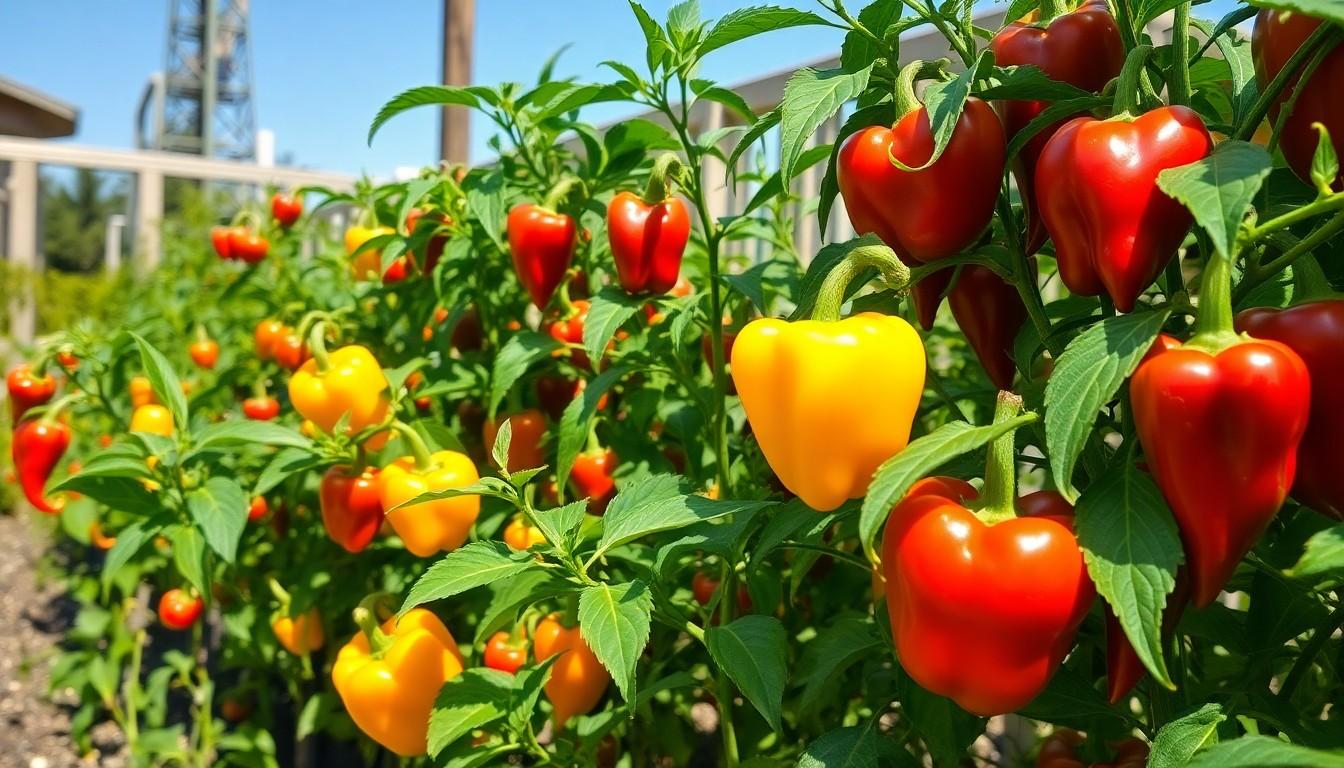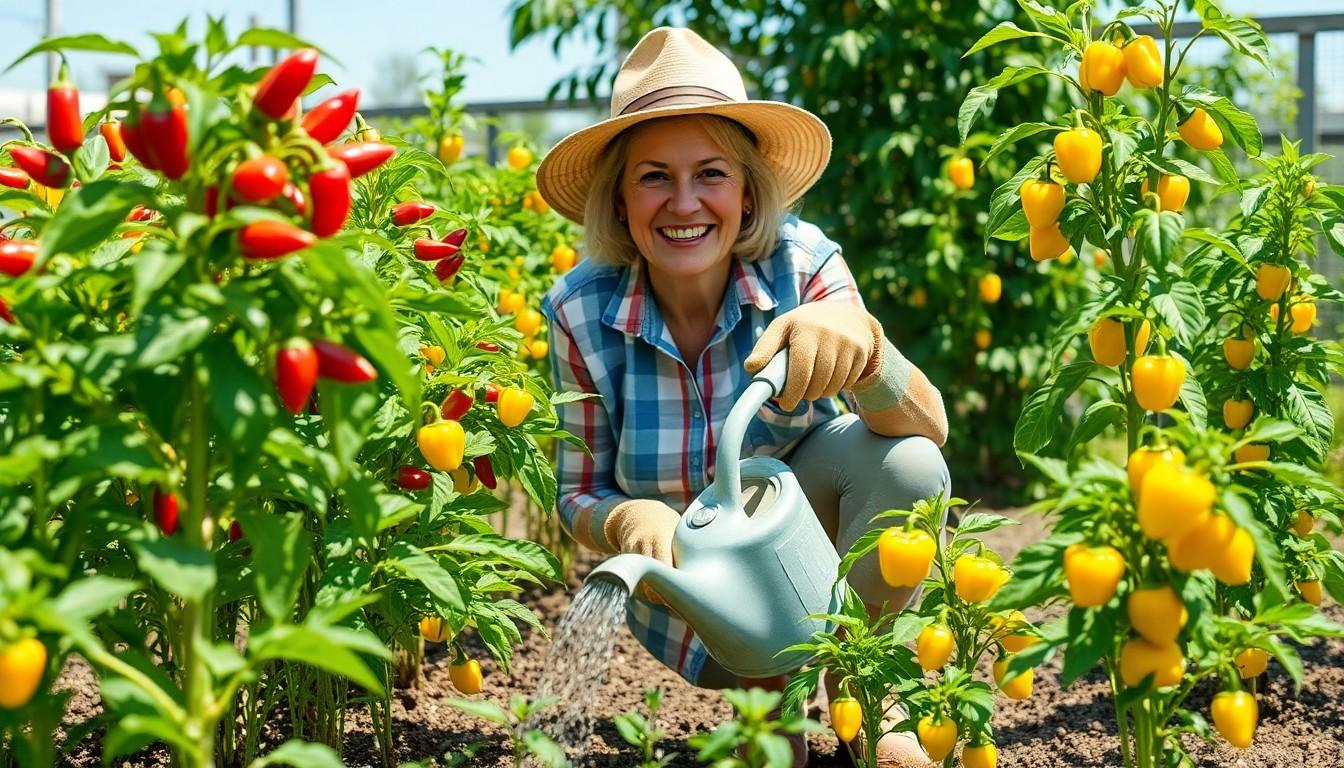Growing pepper plants can be a spicy adventure, and who wouldn’t want to add a little heat to their garden design? Whether you’re aiming for fiery jalapeños or sweet bell peppers, these vibrant plants can bring life to any space. With the right care, they’ll reward you with a bountiful harvest that’ll make your taste buds dance.
Pepper Plant Care
Pepper plants thrive with consistent care, requiring attention to their specific needs. Watering plays a crucial role, as these plants prefer evenly moist soil, not soggy or dry conditions. Daily checks ensure that moisture levels remain ideal, especially during hot weather.
Light exposure significantly impacts growth. Full sun, or at least six hours of direct sunlight, benefits pepper plants most effectively. Inadequate light stunts their development, leading to fewer fruits.
Fertilization provides essential nutrients. Using a balanced fertilizer every four to six weeks promotes healthy growth and fruit production. Nutrient-rich soil supports vibrant, flavorful peppers.
Temperature affects overall health. Pepper plants thrive in temperatures ranging from 70 to 85°F (21 to 29°C). Excessively low temperatures can impede growth, while extreme heat may lead to blossom drop.
Pruning ensures proper air circulation, reducing disease risk. Removing excess leaves and spent flowers encourages robust plant health, enabling better fruit yield. Regular inspections for pests, such as aphids or spider mites, safeguard against infestations.
Mulching helps retain soil moisture and suppress weeds. Organic materials like straw or wood chips provide insulation while maintaining the desired growing conditions.
Harvesting peppers at the right time enhances flavor. Picking them when they reach the desired color yields the best taste. Storing harvested peppers in a cool place preserves quality.
Adhering to these care guidelines results in a bountiful pepper harvest, enriching both gardens and meals alike.
Choosing The Right Pepper Plant
Selecting the right pepper plant sets the foundation for a successful garden. Various factors contribute to this choice, such as the types of peppers desired and specific growing conditions.
Popular Pepper Varieties
Several pepper varieties stand out among gardeners. Bell peppers offer a sweet, mild flavor and versatility in cooking. Jalapeños, known for their moderate heat, are ideal for salsas and grilling. Habaneros deliver intense heat and fruity undertones, perfect for hot sauce enthusiasts. Anaheim peppers provide a milder spice, making them excellent for stuffing and roasting. Consider exploring specialty varieties like ghost peppers for spice lovers or ornamental peppers that add color to garden spaces.
Considerations For Selection
Local climate significantly impacts pepper plant success. Warmer regions might favor heat-loving varieties, while cooler areas may require more tender options. Assessing growth space is crucial; some peppers spread widely, requiring ample room. Disease resistance should also factor into decisions, as certain varieties are more resilient. Taste preferences often dictate choices as well; some gardeners may prioritize sweetness versus heat. Finally, consider the intended use—fresh consumption, cooking, or preservation—all influence the ideal pepper selection.
Essential Growing Conditions
Pepper plants thrive under specific growing conditions that ensure their healthy development. Attention to light, soil, and water significantly influences their growth and productivity.
Light Requirements
Pepper plants require a minimum of six hours of direct sunlight daily. During summer, full sun exposure boosts growth and fruiting. In areas with intense heat, some afternoon shade protects the plants from stress. Providing adequate light avoids leggy growth and helps maintain robust foliage. Observing these light needs fosters optimal yield and healthier plants.
Soil Quality
Well-draining soil is crucial for pepper plants, as they prefer sandy loam or loamy soil enriched with organic matter. A pH level between 6.0 and 7.0 optimizes nutrient absorption. Amending soil with compost or well-rotted manure enhances fertility and soil structure. Regular testing ensures the right nutrient balance is maintained. Proper soil quality supports vigorous growth and vibrant fruit color.
Watering Needs
Regular watering is essential for pepper plants, aiming for consistent moisture without waterlogging. The soil should remain evenly moist, particularly during flowering and fruit set. In hot, dry weather, daily watering might be necessary, while less frequent watering suffices in cooler conditions. Mulching helps retain soil moisture and regulate temperature. Meeting these watering needs promotes healthy root systems and improves overall plant vigor.
Fertilization And Nutrient Management
Fertilization is crucial for vibrant pepper plant growth. It ensures plants receive vital nutrients, enhancing both yield and flavor.
Types Of Fertilizers
Organic fertilizers, such as compost and well-rotted manure, enrich soil structures naturally. Chemical fertilizers provide immediate nutrient availability, helpful for quick growth. Balanced fertilizers, with equal ratios of nitrogen, phosphorus, and potassium, suit most pepper plants. Granular types work well for slow-release benefits. Liquid fertilizers promote faster nutrient uptake during active growth stages. It’s essential to choose fertilizers based on specific growth phases and soil conditions.
Application Techniques
Applying fertilizers correctly maximizes their benefits. Broadcasting granules around the base of plants delivers even distribution. Watering immediately after application helps integrate nutrients into the soil. Foliar feeding offers a quick nutrient surge; it’s beneficial during critical growth periods. Fertilization every four to six weeks sustains optimum nutrient levels. Adjusting application techniques based on growth stages ensures that plants receive ideal nutrient support throughout their development.
Common Pests And Diseases
Pepper plants face several pests and diseases that can impede their growth. Recognizing symptoms early can help maintain plant health and yield.
Identification And Prevention
Aphids and spider mites commonly infest pepper plants, leading to yellowing leaves and stunted growth. Fungal infections like powdery mildew appear as white patches on leaves. Maintaining proper air circulation and avoiding overhead watering decreases the risk of mildew. Inspecting plants regularly for pests ensures early detection. Introducing beneficial insects such as ladybugs offers an organic solution to manage aphid populations. Utilizing companion planting, like marigolds, repels harmful insects. Crop rotation also helps prevent soil-borne diseases by disrupting pest life cycles.
Treatment Options
Insecticidal soap effectively targets aphids without harming beneficial insects. Neem oil serves as another organic alternative that controls both pests and fungal diseases. Applying these treatments during the early morning or late evening minimizes potential leaf burn. For severe infestations, treating plants with systemic insecticides can be necessary, although caution is important. Removing infected plant parts helps reduce disease spread. Moreover, adhering to proper watering techniques promotes resilience against many pests and diseases. Consistent monitoring and timely intervention maintain healthy pepper plants.
Ongoing Maintenance Tips
Ongoing maintenance of pepper plants focuses on consistent practices that foster healthy growth. Watering should occur regularly to maintain evenly moist soil. Soil that remains too dry can stress plants, while overwatering may lead to root rot.
Fertilizing every four to six weeks supports nutrient availability throughout the development of the plants. Balanced fertilizers containing equal parts nitrogen, phosphorus, and potassium promote vibrant growth. Consider organic options like compost and well-rotted manure for sustainability.
Proper pruning enhances air circulation and reduces disease risk. Remove dead or yellowing leaves promptly to divert energy toward fruit production. Mulching also plays a crucial role in retaining soil moisture and suppressing weed growth.
Pest management requires regular inspections for early detection. Aphids and spider mites can damage plants and hinder their development. Introducing beneficial insects, such as ladybugs, creates a natural defense mechanism against harmful pests.
Providing at least six hours of daily direct sunlight is essential for better yields. Afternoon shade during extremely hot weather protects plants from heat stress. Adjusting light exposure based on the season promotes optimal growth conditions.
Temperature monitoring supports healthy pepper plant development. Keeping temperatures within 70 to 85°F (21 to 29°C) ensures plants thrive throughout the growing season. Additionally, maintaining proper air circulation adds another layer of protection against disease.
Investing time in ongoing maintenance results in a bountiful harvest. Each step, from watering to pest management, contributes to a productive pepper garden. Consistency in these practices significantly enhances the overall health and yield of pepper plants.
Enhancing Your Garden
Caring for pepper plants can be a rewarding experience that enhances any garden. By focusing on their specific needs such as sunlight, water, and nutrients, gardeners can ensure vibrant growth and a plentiful harvest. Regular monitoring for pests and diseases plays a vital role in maintaining plant health.
With the right practices in place, pepper plants can thrive and produce delicious fruits that elevate meals and add color to outdoor spaces. Embracing these care techniques not only fosters a successful garden but also cultivates a deeper appreciation for the art of gardening.


